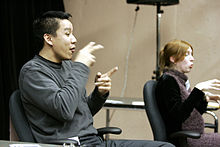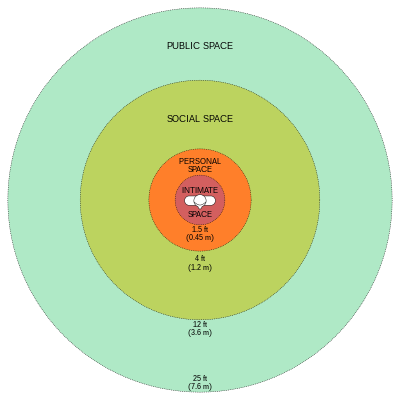4.2: Human Nonverbal Communication
- Page ID
- 5303

We use body language, eye contact, gestures, posture, and facial expressions to communicate with one another. Although the majority of nonverbal communication studies first researched by Ray Birdwhistell focus on face-to-face encounters between two or more people, advances in technology are creating new forms of nonverbal communication. Handwriting styles and emoticons can be included in this new category. Emoticons, which are often used in text messaging, serve to more clearly express a point or add context to what is being communicated since one's tone of voice and facial expressions cannot be seen at the time of viewing.
Nonverbal communication can be an incredibly effective way of sending and receiving messages from person to person, especially in a foreign country. For example, you can communicate hunger through making a gesture pointing to your stomach or your mouth, a universal sign. Often people will use this rudimentary sign language to speak to others when they need something. Another subtle yet common form of nonverbal communication is facial expressions. It's easy to portray being happy or sad or confused. However, there are other social expressions in foreign countries that become important to pay attention to. For example, when giving a speech at a table in Sweden, it's expected to make direct eye contact with others, contrary to Japan, where eye contact is seen as rude and disrespectful, especially in public areas.
Nonverbal communication can also lead to things that people did not mean to communicate. For example a person from American culture sees kissing as a sign of affection but in some Spanish speaking countries, kissing is a way to greet someone. There are also certain ways to kiss someone in those countries depending on what your relationship is to that person. If two people from these places meet and one of them comes in for a kiss because they think they are greeting them properly the other person might become confused as to why the other person is trying to kiss them. Sometimes nonverbal communication can bring to light the many cultural differences that there are around the world.
Clothing has been known to be a form of communication or expression, as well. For example, the chief of a Native tribe will dress more extravagant than other members of the tribe, such as a piece like a feathered headdress. Great hunters wear animal skins to show off a kill in some hunter-gatherer communities. Another cultural piece of clothing would be a wedding dress. It is meant to be worn on the day that two people get married and is typically never to be worn again. Oftentimes couples spend thousands on said dress because it is a special occasion to show the love of the couple to the people they care about. Sometimes the physical—what a person wears, how they move, or how they express emotions—can mean more than words, providing little clues into cultures.
Proxemics


Proxemics, coined by anthropologist Edward T. Hall in 1966, is the amount of space that people feel necessary to put between themselves and others as they interact. The category of proxemics is most commonly sub-grouped into a physical territory and personal territory, although proxemics can also be identified in several other forms such as eye-contact, facial expression, smells, body warmth, gender, and the number of people involved. The area of the personal territory is further sub-grouped as public space- ranging in 12–25 feet between people, social space- ranging from 4–10 feet between people, personal space between 2–4 feet of separation and finally intimate space- a foot or less of separation.[3] The physical distance between them is related to their social distance. For example, people who know each other very well often communicate in the intimate space, which is about 1.5 feet away from each other, whereas acquaintances will usually communicate about 12 feet from each other.[4]
Proxemics can vary by culture, gender, social setting and individual preference. For example, in U.S. grocery stores it is considered polite to leave the person in front of you in line plenty of personal space. In China, however, due in large part to its denser population, it is common to leave less than a two-foot gap between you and the person in front of you in line.

Chronemics
Chronemics is a field of study examining the utilization of time in nonverbal communication. Perceptions of time can play significant roles in various forms of nonverbal communication. For example, a slight pause before finishing an announcement can help to build a sense of anticipation in one's audience. Aside from the transmission of mood, time can also figure into communication in terms of attention span and the expression or reinforcement of power relationships. A culture's perception of time not only influences the way they communicate but also the way they organize and execute their daily lives. Cultures are divided into two main groups based on the way that members of that culture generally perceive time: monochronic cultures and polychronic cultures.
Monochronic cultures
Monochronic cultures are societies made up of people that appreciate doing one task at a time without interruption or tardiness, people in these cultures tend to believe that time is linear. The contemporary United States is a monochronic culture. People in the US tend to keep very rigid schedules, and usually value punctuality, brevity, and adherence to plans made in advance. In the US, time is viewed as a resource, as is illustrated by the common expression "time is money". People living in monochronic cultures tend to focus on the completion of one task at a time, and usually, view interruption and distraction as things to be avoided. Monochronic cultures like the US, look down upon being late. When there is a schedule and it is not followed, there are often consequences and social respect is sometimes lost.
Polychronic cultures
Polychronic cultures tend to see time as fluid and malleable. Characteristics of polychronic cultures include interrupted meetings, flexible schedules, and higher values placed in people and relationships over punctuality and deadlines.[4] Examples of polychronic cultures are those found in modern Mexico and Egypt. People of these cultures tend to keep open schedules, often altering plans without notice and "double-booking" themselves. In monochronic cultures such as the United States, Germany, and Great Britain these behaviors are thought to be inefficient and improper. People of polychronic cultures are more susceptible to distractions and open to interruption but are better at focusing on many tasks at once. Polychrons prefer to keep their time unstructured, changing from one activity to another as the mood takes them. Although polychrons can meet deadlines, they need to do so in their own way. A polychron does not want detailed plans imposed upon him, nor does he want to make his own detailed plans. Polychrons prefer to work as they see fit without a strict schedule, following their internal mental processes from one minute to the next.[5]
Kinesics
Defined by a study of how “body movements and gestures serve as a means of nonverbal communication”. In short, different movements of your body convey particular ideas and kinesics is how nonverbal communication is interpreted, which will greatly vary across cultures. Through body movements, it is possible to send signals, leaning forward when someone is talking to show you are engaged and listening. Being aware of kinesics can be an aid in relationships, job interviews, or when meeting new people.
This term was first used by Ray Burdwistel in 1952, an anthropologist who studies this certain movement. He argued that all movements of the body meant something. He said that nothing was done by accident, and every movement was used to say how the person was feeling.
Posture

Posture is a type of nonverbal communication, the position in which someone holds their body when standing or sitting. It is also meant to show a way of dealing with or considering something. Much can be interpreted from a person's posture such as their view of themselves, their mood, etc. Such behavior can be intended to impress or mislead another individual in a particular attitude or mood. Posture is used to determine a participant’s degree of attention or involvement, the difference in status between communicators, and the level of fondness a person has for the other communicator.
Gesture
A gesture is a form of non-verbal communication. It is a distinguished physical movement that is an expression of inner thoughts and emotions. Gestures can range from full-body expressions such as dancing or hugging to smaller gestures in the hands or arms such as a slap across the face, or facial gestures such as scrunching of the face to convey discomfort or disgust. Gestures vary widely across cultures, just as vastly as spoken language. In the United States, for example, a commonly accepted gesture of anger is holding up your middle finger, but this emotion can be expressed via a hand flick under the chin in Spain and Latin America or a thumbs up in Iran and Iraq.
Haptics
Haptics is used to refer to the sense of touch and touching capabilities. Haptics can be broken down and organized into three different fields.
Haptic Communication is the way that people communicate based solely through touch. This sense is important for humans because it provides information about objects that we touch and it is also a part of nonverbal communications. Touch can send a very strong message (positive, negative, sexual, or platonic). Haptic Communication is a key to physical intimacy. According to research conducted by Jones and Yarbrough (1985) there are 7 different types of touch, and they are positive touches, playful touches, control touches, ritualistic touches, hybrid touches, task related touches, and accidental touches.
Haptic Technology is a technology that interfaces with the user through the sense of touch. An example of this might be all of the touch screen cell phones that have become very popular in the U.S.
Haptic Perception is used when we recognize an object by touching it. It involves the combination of the senses in the skin, the position of the hand, and conformation. This is used in many everyday actions. An example of this would be using your hand to dig around in your bag looking for a particular object, like a cell phone or a pen. This haptic is particularly useful for the blind who may rely entirely upon touch in order to identify an object since they cannot see it.
An ethnographic representation of haptics in different cultures depends on what is socially acceptable. For example, in the United States it is usually a form of positive touching when you pat someone's head, but in the Thai culture, it is rude to touch someone's head.
Eye Contact

Eye contact is one of the most important forms of nonverbal communication between people. Eye contact signals vary from culture to culture and vary among certain religions as well. For example, in America, someone who is unable to maintain eye contact is seen as not confident, shy, or submissive. In some Arab countries, a person who is unable to maintain eye contact is seen as disrespectful.
Some cultures, such as South Asia, might view extended eye contact as challenging, rude, and aggressive. In the Islamic faith, Muslims often lower their gaze and do not look at the opposite gender’s eyes after the initial greeting. This is because lustful glances to those of the opposite gender are prohibited. What is considered harmless flirting in some western cultures may be seen as a form of adultery in Islam. In English-speaking cultures, a certain amount of eye contact is required in daily social situations but too much eye contact can have misdirected meaning, often misinterpreted.


